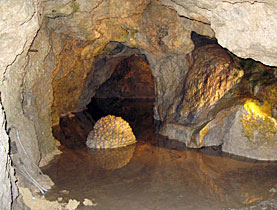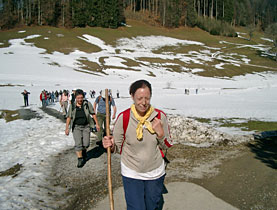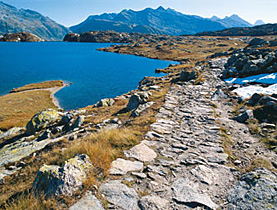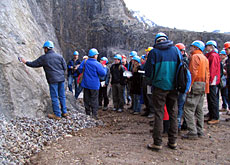Deep thrills under the Swiss surface

Switzerland's mountains may be top of most travellers' lists, but its caves are also worth exploring. And their cool climates offer relief from the summer heat.
Caves of all sizes and textures beckon from their underground hideaways, many of them accompanied by legends.
Day-tripping spelunkers can easily visit places like the “coral crevice”, “spaghetti grotto” and “witch’s cauldron”, while the super-keen can spend the whole night inside a cave.
Located high on a cliff-side overlooking Lake Thun, the Saint Beatus Caves near Interlaken have been drawing visitors for hundreds of years. They got their name from the Irish saint who lived there in the sixth century.
“When Beatus arrived, the local people told him that there was a dangerous dragon living in this cave,” says Marie-Blanche Schwaller, deputy director of the caves.
“Beatus said, ‘No problem,’ walked up with his pilgrim staff and drove out the dragon.” According to the legend, the angry dragon fell from the cliff and into the lake, which began to boil.
Afterward, Beatus settled into the snug, dry cave to preach Christianity until he died at age 90. His grave at the cave’s mouth became a popular destination for pilgrims following the Way of St James.
There was once a chapel and a pilgrim hostel near the cave entrance, but these were destroyed during the Reformation.
Digging deeper
Centuries later, nature enthusiasts began exploring the cave system further. In their current state, the caves reflect the efforts of independent explorers in the 1800s and the committee charged with creating a tourist attraction in 1904.
Their work paid off; today, some 65,000 people per year visit the Saint Beatus Caves, which are open from April to October. What awaits them is a kilometre-long trail that passes through a stunning chain of grottoes revealing stalactites and stalagmites, waterfalls and small ponds.
Bats live in the vicinity, but not within the caves. However, some of the larger rock formations resemble animals such as a giant tortoise and a sleeping bear.
“If you have fantasy you can see animals everywhere. When the children walk at the front of a tour group, they can see a lot of things that we adults don’t see,” says Schwaller, who has been leading cave tours for nearly two decades.
Electricity provides enough light and there are manmade footpaths and stairs. Still, visitors need a certain level of surefootedness as the surfaces can be wet and slippery.
Underground lake
Canton Valais is home to the world’s largest natural underground lake. Located near Sion, Lac Souterrain de St-Léonard has a surface area of about 6,000 square metres.
Rather than exploring the cave on foot, visitors experience it by boat. Rowing guides ferry guests for 30-minute tours of the lake, which is ten metres deep. The ethereal atmosphere is enhanced by the lanterns and the reflections on the lake’s surface.
Discovered in 1943, the underground lake was opened to the public six years later. In honour of its 60th anniversary, visitors born in 1949 get free admission this year.
Hell’s grottoes
Those who’d prefer to take a self-guided tour can go to hell – “Hell’s Grottoes”, that is. Just off the Zurich-Lucerne axis, the Höllgrotten lie in a hidden valley in Baar.
The first cave was discovered in 1863 as builders sought stone material for the train line between Zug and Zurich. Other sections were unearthed in 1892 and 1902.
Divided into two separate systems, these caves feature some attractive stalactites and stalagmites.
One section, called the “magic castle”, has rock formations that resemble organ pipes. If tapped gently with a knuckle, they even reverberate like musical instruments.
Adventure tours
Those with more time (and guts) can embark upon tours lasting anywhere from a few hours to a couple of days. These types of expeditions are led by professional guides and require special equipment like headlamps, helmets, rubber boots and perhaps waterproof overalls.
“Caving tours make your head free, because you concentrate on your steps, your moves and on the cave itself. Staying in a cave for two days boosts those feelings and makes the experience more intense,” says Gery Aeschlimann of Trekking Team AG, a company that organizes tours of the Hölloch (Hell-hole) cave in canton Schwyz.
Meanwhile, a long journey into the bowels of the earth might have some wondering about sanitary facilities.
“Before we start a tour, we tell our guests to go to the bathroom first. In the cave the possibilities are not so good anymore. But in the bivouac, where we have our two-day tours, we do have a toilet,” says Aeschlimann.
Asked about safety, Aeschlimann compares caving to biking or jogging. In the 20 years the Trekking Team has been organising tours, they have never had an accident.
Wherever one chooses to go, one thing is certain, according to Aeschlimann: “Tours in caves are always experiences you never will forget.”
Susan Vogel-Misicka, swissinfo.ch
Often found in limestone caves, these are formed as water drips from the ceiling and down walls.
The average growth rate is a mere 0.13mm per year.
Inside the Saint Beatus Caves, the “Koh-i-noor” stalagmite is an estimated 40,000 years old.
There are many caves that are open to the public, while others are open to researchers only.
Even if it’s 30°C outside, the temperature inside a cave will be cool and the ground may be slippery. Closed, rubber-soled shoes are a must.
Some caves drip water, so a waterproof jacket is a good idea.

In compliance with the JTI standards
More: SWI swissinfo.ch certified by the Journalism Trust Initiative




You can find an overview of ongoing debates with our journalists here. Please join us!
If you want to start a conversation about a topic raised in this article or want to report factual errors, email us at english@swissinfo.ch.